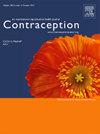Society of Family Planning Clinical Recommendation: Management of undesired pregnancy of unknown location and abortion at less than 42 days of gestation
IF 2.3
2区 医学
Q1 OBSTETRICS & GYNECOLOGY
引用次数: 0
Abstract
Pregnancy of unknown location is a condition in which a pregnancy test is positive, but no intrauterine or extrauterine pregnancy is visualized using transvaginal ultrasonography. We recommend using standardized nomenclature and definitions to describe intrauterine pregnancy (IUP), probable IUP, pregnancy of unknown location (PUL), probable ectopic pregnancy (probable EP), and ectopic pregnancy (EP) (Best Practice). Among abortion-seeking patients found to have a PUL, the incidence of EP is 4% to 8%. We recommend clinical judgment in assessing the risk for EP in the setting of PUL; the absence of an intrauterine gestational sac (GS) or yolk sac should not delay care (GRADE 1B). In asymptomatic individuals with an undesired PUL who prefer to proceed with immediate treatment (medication or procedural management without delay) and have a low risk of EP, as determined by the clinician based on history, symptoms, and all other available data, we recommend medication management with mifepristone and misoprostol or procedural management via uterine aspiration and clear plans for ensuring pregnancy resolution in a timely fashion (GRADE 1B). While both medication and procedural management of undesired PUL are associated with earlier pregnancy resolution and identification of EP, the two main risks of inadequate follow-up include ongoing pregnancy and missing or delaying a subsequent diagnosis of EP. For individuals with PUL choosing immediate treatment with medication management, we recommend clinicians obtain a baseline serum quantitative human chorionic gonadotropin (hCG) at the time of medication provision to aid in diagnosis and follow-up (GRADE 1A). Following medication management of PUL with mifepristone and misoprostol, we suggest a repeat serum quantitative hCG level, with pregnancy resolution defined as either a 50% decline or greater at 48 to 72 hours after misoprostol or an 80% decline or greater at 7 days after mifepristone or 5 to 10 days after misoprostol (GRADE 2B). We recommend against direct extrapolation of follow-up recommendations from no-test abortion clinical protocols to individuals with a documented PUL treated with mifepristone and misoprostol, given the higher risk of EP among individuals with a known PUL (GRADE 1C). When uterine aspiration is performed at less than 42 days of gestation, including for individuals with PUL or probable IUP, and both chorionic villi and GS are not visualized, we recommend repeat ultrasonography (if an IUP or probable IUP was seen initially), serum quantitative hCG follow-up, or both (GRADE 1B). When both chorionic villi and GS are not visualized after uterine aspiration and serial serum hCG follow-up is warranted, we recommend testing on the day of the procedure and 24 to 72 hours later, with pregnancy resolution defined as greater than 50% decline 24 hours after aspiration, greater than 70% by 48 hours, or greater than 80% by approximately 72 hours (GRADE 1B).
美国计划生育学会临床建议:处理不明部位意外妊娠和妊娠少于42天流产。
不明位置妊娠是指妊娠试验呈阳性,但经阴道超声检查未发现宫内或宫外妊娠的情况。我们建议使用标准化的术语和定义来描述宫内妊娠(IUP)、可能IUP、不明位置妊娠(PUL)、可能异位妊娠(probable EP)和异位妊娠(EP)(最佳实践)。在寻求流产的患者中发现有PUL,异位妊娠(EP)的发生率为4-8%。我们建议在评估PUL患者发生EP的风险时进行临床判断;没有宫内妊娠囊(GS)或卵黄囊不应延误护理(1B级)。对于无症状的不良PUL患者,如果临床医生根据病史、症状和所有其他可用数据确定其EP风险低,且倾向于立即进行治疗(药物或程序性管理),我们建议使用米非司酮和米索前列腺醇进行药物管理或通过子宫抽吸进行程序性管理,并制定明确的计划以确保妊娠及时解决(1B级)。虽然药物治疗和程序管理与妊娠早期缓解和EP的识别有关,但随访不充分的两个主要风险包括持续妊娠和遗漏或延迟EP的后续诊断。对于选择立即药物治疗的PUL患者,我们建议临床医生在提供药物治疗时获得基线血清定量hCG,以帮助诊断和随访(GRADE 1A)。在米非司酮和米索前列醇联合用药后,我们建议重复血清定量hCG水平,妊娠缓解定义为在米索前列醇治疗后48-72小时下降50%或更高,或在米非司酮治疗后7天或米索前列醇治疗后5-10天下降80%或更高(2B级)。考虑到已知PUL (1C级)患者发生EP的风险较高,我们不建议将无检测流产临床方案的随访建议直接外推到使用米非司酮和米索前列醇治疗的有记录的PUL患者。当在妊娠少于42天进行子宫抽吸时,包括有宫内妊娠或可能宫内妊娠的个体,并且绒毛膜绒毛和GS都没有可见,我们建议重复超声检查(如果最初发现宫内妊娠或可能宫内妊娠),血清定量hCG随访,或两者兼有(1B级)。当子宫抽吸后未观察到绒毛膜绒毛和GS时,需要进行连续的血清hCG随访,我们建议在手术当天和24-72小时后进行检测,妊娠消退定义为抽吸后24小时下降50%以上,48小时下降70%以上,或约72小时下降80%以上(1B级)。
本文章由计算机程序翻译,如有差异,请以英文原文为准。
求助全文
约1分钟内获得全文
求助全文
来源期刊

Contraception
医学-妇产科学
CiteScore
4.70
自引率
17.20%
发文量
211
审稿时长
69 days
期刊介绍:
Contraception has an open access mirror journal Contraception: X, sharing the same aims and scope, editorial team, submission system and rigorous peer review.
The journal Contraception wishes to advance reproductive health through the rapid publication of the best and most interesting new scholarship regarding contraception and related fields such as abortion. The journal welcomes manuscripts from investigators working in the laboratory, clinical and social sciences, as well as public health and health professions education.
 求助内容:
求助内容: 应助结果提醒方式:
应助结果提醒方式:


